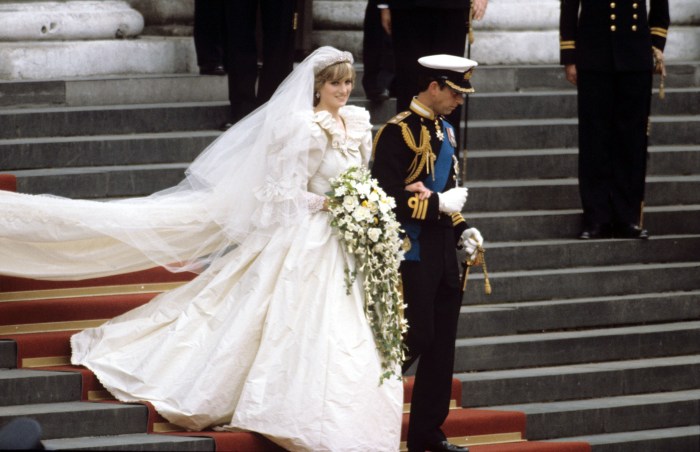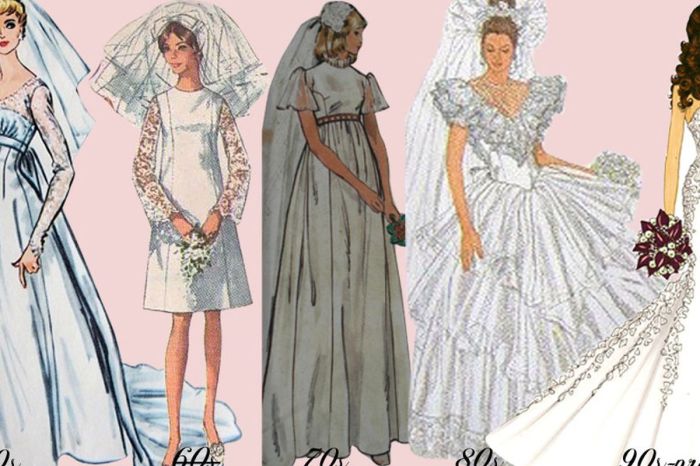Victorian Wedding Dresses A History
Victorian Wedding Dress Silhouettes: A Century of Style

Source: wwd.com
Victorian wedding dresses history – The Victorian era, spanning from 1837 to 1901, witnessed a remarkable evolution in wedding dress silhouettes. Changes in societal norms, technological advancements in fabric production, and the influence of royal weddings all contributed to the diverse range of styles seen throughout this period. This exploration details the key shifts in design, focusing on the prominent silhouettes, fabrics, and embellishments that defined each decade.
Evolution of Victorian Wedding Dress Silhouettes
Victorian wedding dress silhouettes underwent a significant transformation from the early to the late Victorian era. Early Victorian gowns were characterized by a more restrained elegance, gradually evolving into the more elaborate and dramatic styles of the later years. Necklines, waistlines, and skirt shapes all played crucial roles in defining these evolving silhouettes.
Victorian wedding dresses, known for their elaborate detail and often voluminous silhouettes, represent a fascinating period in bridal fashion. The influence of other styles is evident; for instance, the incorporation of lace and rich fabrics sometimes echoes elements found in spanish style wedding dresses , particularly in the use of ornate embroidery. However, Victorian gowns ultimately maintained their distinct aesthetic, showcasing a unique blend of romanticism and formality.
Comparison of Dominant Silhouettes Across Decades
Source: lulus.com
| Decade | Silhouette Description | Common Fabrics | Notable Features |
|---|---|---|---|
| 1840s | High-waisted, emphasizing a slender, elongated figure. Full skirts, often with a slight bustle. | Lightweight muslins, sheer fabrics, and fine cottons. | Simple necklines, often featuring a high collar or a modest V-neck. Sleeves were usually long and full. |
| 1860s | The crinoline era, featuring bell-shaped skirts supported by a cage-like structure. Defined waistline, often emphasized with a belt or sash. | Silk, satin, and heavier fabrics like brocade became more common. | More elaborate embellishments, including lace, embroidery, and ribbons. Necklines could be higher or lower, depending on fashion trends. |
| 1890s | The S-bend silhouette, with a dramatic curve at the waistline, accentuated by a bustle or padding. Long, flowing skirts with a train. | Silk, satin, velvet, and lace were favored. | Elaborate lace and embroidery were common. Necklines were often high, with a fitted bodice. Long sleeves were prevalent. |
Influence of Prevailing Fashion Trends
Victorian wedding dress design was heavily influenced by broader fashion trends of the time. The popularity of specific fabrics, necklines, and embellishments in everyday wear often translated into bridal fashion. For instance, the introduction of new dyeing techniques led to a wider range of colors in both everyday clothing and bridal gowns. The adoption of the crinoline and the bustle, initially seen in general fashion, significantly impacted the shape and structure of wedding dresses.
Fabrics and Materials in Victorian Wedding Dresses: Victorian Wedding Dresses History
The fabrics used in Victorian wedding dresses played a significant role in reflecting the bride’s social standing and the overall aesthetic of the gown. The availability and cost of fabrics varied over time, influencing both the choice of material and the level of embellishment.
Common Fabrics and Their Social Connotations
- Silk: A luxurious fabric, signifying wealth and status. Different types of silk, such as satin, taffeta, and brocade, were used to create varying levels of texture and sheen.
- Lace: Widely used, ranging from delicate handmade lace, indicative of high social standing, to less expensive machine-made lace.
- Cotton: A more affordable option, often used by brides from lower social classes. Fine cottons could still create beautiful and elegant gowns.
- Velvet: Used for richer, more opulent gowns, especially in the later Victorian era. Often incorporated as accents or for specific details.
- Muslin: A lightweight, sheer fabric, popular in the early Victorian era for its airy quality.
Embellishment Techniques, Victorian wedding dresses history
Victorian wedding dresses were often lavishly embellished, reflecting the craftsmanship and artistry of the time. Common techniques included intricate embroidery, delicate lacework, and sparkling beading. Styles ranged from simple floral patterns to elaborate designs featuring motifs like birds, flowers, and religious symbols. The use of pearls, sequins, and other decorative elements added to the overall opulence of the gowns.
Color and Symbolism in Victorian Wedding Attire
While white eventually became the dominant color for Victorian wedding dresses, other colors held significance and were used depending on social class, religious beliefs, and personal preferences. The symbolic meaning of colors played a crucial role in the overall message conveyed by a bride’s attire.
Prevalent Colors and Their Symbolic Meanings
White, while not universally adopted initially, came to symbolize purity and innocence. Other colors, such as cream, ivory, and even shades of pastel blue or pink, were also common. These lighter colors still held connotations of purity and virtue. Brides from less affluent backgrounds might choose more practical and readily available colors.
The Evolution of White as the Dominant Color
Queen Victoria’s choice of a white satin gown for her wedding in 1840 is widely credited with popularizing white as the quintessential wedding dress color. Before this, brides wore a variety of colors, often reflecting their existing wardrobe or family traditions. Victoria’s choice, however, set a trend that continues to this day.
Color Across Social Classes and Religious Traditions
| Color | Social/Religious Significance |
|---|---|
| White | Purity, innocence (increasingly dominant across classes); associated with wealth due to the cost of white fabrics. |
| Cream/Ivory | Purity, less expensive alternative to pure white, still signifying virtue. |
| Other Pastels (blue, pink) | Often associated with youth and innocence; less common than white or cream. |
| Darker Colors (depending on fabric and embellishment) | More common in lower social classes; practicality and availability of materials. |
Accessories and Details in Victorian Wedding Dresses
Victorian wedding dresses were often complemented by a range of accessories that added to their overall elegance and conveyed social status. These details, from delicate veils to elaborate jewelry, contributed to the bride’s complete ensemble.
Common Accessories and Their Significance

Source: vox-cdn.com
Veils, often made of lace or tulle, symbolized modesty and purity. Gloves, typically long and made of delicate materials, were a common accessory. Jewelry, such as pearl necklaces and earrings, added a touch of opulence. Elaborate headpieces, ranging from simple floral wreaths to more ornate creations, completed the look. The choice and quality of these accessories often reflected the bride’s wealth and social standing.
A Typical Victorian Bride’s Ensemble
Imagine a bride adorned in a flowing gown of ivory silk, the bodice fitted and accented with delicate lace. The full skirt, perhaps supported by a bustle, trails elegantly behind her. A long, sheer veil cascades down her back, framing her face. She wears elegant pearl earrings and a matching necklace, and delicate lace gloves cover her hands.
A simple wreath of orange blossoms crowns her head, adding a touch of natural beauty to her ensemble. This image, while varied in specifics depending on the era and social class, captures the essence of Victorian bridal style.
Influence of Royal Weddings on Victorian Bridal Fashion
Royal weddings significantly impacted Victorian bridal fashion, setting trends that were widely imitated across social classes. The influence of these events is evident in the evolution of silhouettes, fabrics, and embellishments used in wedding dresses.
Key Influences of Notable Royal Weddings
| Wedding | Year | Key Features of Dress | Impact on Popular Fashion |
|---|---|---|---|
| Queen Victoria & Prince Albert | 1840 | White satin gown, high neckline, long sleeves, simple but elegant design. | Popularized white as the dominant wedding dress color. |
| (Add other relevant royal weddings and their impact here) |
The Evolution of the Victorian Wedding Veil
The wedding veil, a symbol of modesty and purity, underwent its own evolution during the Victorian era. Different styles, lengths, and materials reflected the changing fashion trends and social norms of the time.
Styles, Lengths, and Materials of Victorian Wedding Veils
Early Victorian veils were often simple and short, made of lightweight materials like lace or tulle. As the era progressed, veils became longer and more elaborate, incorporating intricate lacework and embellishments. The length and style of the veil could also indicate social status, with longer, more ornate veils associated with wealthier brides. The symbolism of the veil remained consistent, representing the bride’s transition into a new phase of life, protected and blessed.
Symbolism and Significance of the Wedding Veil
The veil held deep symbolic meaning in Victorian society, representing modesty, purity, and the bride’s transition into marriage. It was seen as a way to protect the bride from evil spirits and to ensure good fortune in her new life. The veil’s length and embellishments often reflected the bride’s social status and personal style.
Clarifying Questions
What was the average cost of a Victorian wedding dress?
The cost varied drastically depending on the bride’s social class and the extravagance of the dress. A simple dress could be relatively affordable, while elaborate gowns with expensive fabrics and embellishments could cost a significant sum, sometimes equivalent to several years’ wages for a working-class individual.
Were there any specific traditions surrounding the disposal of a Victorian wedding dress?
There weren’t widely documented specific traditions regarding disposal. However, some dresses were repurposed into other garments, passed down through families, or carefully stored as keepsakes. The preservation or reuse of the dress depended largely on the family’s resources and sentimental attachment.
How did the rise of photography impact Victorian wedding attire?
The advent of photography increased the importance of visual presentation. Brides were more conscious of how their attire would appear in photographs, leading to a greater emphasis on elaborate details and posing.



















